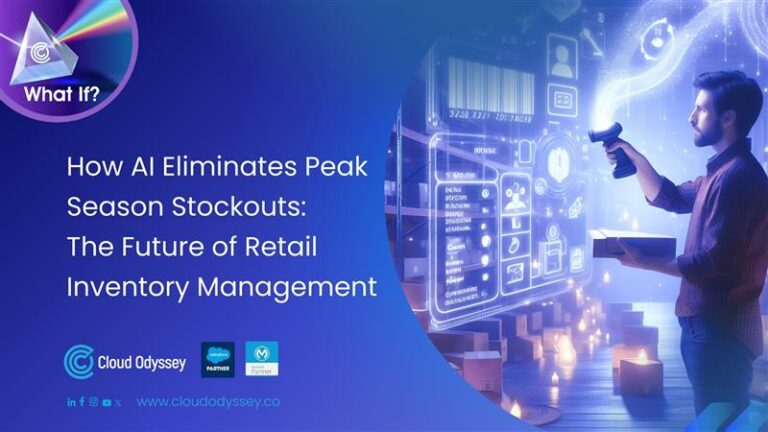The Peak Season Paradox: When Success Becomes Your Biggest Challenge
Picture this: Black Friday arrives, your marketing campaigns have generated unprecedented traffic, customers are ready to buy—and then disaster strikes. Your best-selling products are out of stock. Industry data reveals a sobering truth: retailers lose an estimated $1.1 trillion annually due to stockouts, with peak shopping seasons accounting for nearly 40% of these losses. During the critical Q4 period alone, when retailers generate 20-30% of their annual revenue, stockouts can devastate both immediate sales and long-term customer relationships.
The peak shopping season challenges have evolved dramatically. Modern consumers, armed with mobile devices and influenced by mobile shopping trends, expect instant gratification and seamless experiences. They won’t wait for restocks—they’ll simply click over to a competitor. This creates a paradox where your most successful marketing efforts can expose your biggest operational vulnerabilities.
Traditional inventory management systems, built for predictable demand patterns, crumble under the pressure of holiday sales spikes, flash sales, and viral social media trends. But here’s where the story takes a revolutionary turn: AI in retail is fundamentally transforming how businesses prepare for and navigate peak seasons, turning potential disasters into competitive advantages.
The Hidden Cost of Peak Season Stockouts
The Immediate Impact: More Than Just Lost Sales
Holiday sales insights from recent years paint a stark picture. During peak shopping periods, stockouts don’t just cost individual transactions—they trigger a cascade of business damage. When Amazon ran out of popular items during Prime Day 2019, the company didn’t just lose those specific sales; they lost customers to competitors who captured market share that took months to recover.
Consumer behavior during peak shopping season has fundamentally shifted. Today’s shoppers, influenced by mobile shopping trends and instant-access expectations, exhibit what researchers call “zero-tolerance shopping behavior.” A study by IHL Group found that 70% of consumers will immediately switch to a competitor when faced with a stockout, and 32% will never return to that retailer.
The mobile-first reality amplifies these challenges. Mobile shopping now represents over 55% of all e-commerce traffic during peak seasons, and mobile users expect real-time inventory accuracy. When a customer sees “in stock” on their phone but arrives at a store to find empty shelves, the brand damage extends far beyond that single transaction.
The Ripple Effects: Long-term Brand Damage
Peak season stockouts create ripple effects that persist long after the holidays end. Customer trust, built over months or years, can evaporate in minutes. Social media amplifies these negative experiences, with stockout complaints spreading across platforms and influencing thousands of potential customers.
Consider the competitive advantage loss: while you’re explaining why products aren’t available, competitors are capturing your customers and their lifetime value. Industry research shows that customers acquired by competitors during your stockouts have a 60% likelihood of becoming loyal to those new brands.
The brand reputation impact extends into future seasons. Customers remember peak season disappointments, and these memories influence their shopping behavior for subsequent holidays and major sales events.
The AI Revolution in Retail Inventory Management
Understanding AI-Powered Demand Forecasting
AI in retail represents a fundamental shift from reactive to predictive inventory management. While traditional forecasting relies on historical data and seasonal patterns, AI-powered systems analyze hundreds of variables in real-time, creating dynamic, responsive inventory strategies.
Machine learning algorithms excel where human analysts struggle: processing vast amounts of disparate data simultaneously. These systems analyze historical sales patterns, weather forecasts, social media sentiment, economic indicators, local events, and even competitor activities to predict demand with unprecedented accuracy.
Real-time data processing capabilities mean inventory decisions aren’t based on last week’s data—they’re based on this minute’s reality. When a product starts trending on TikTok or when weather patterns shift unexpectedly, AI systems detect these changes and adjust inventory recommendations immediately.
And when paired with Salesforce technologies, this predictive power becomes operational. Agentforce drives AI-based forecasting, while Data Cloud integrates data from every customer touchpoint—sales, marketing, service, and commerce—into a single, accurate view. Together, they give retailers the ability not just to anticipate demand, but to align inventory decisions with real-time customer behavior.
Key AI Technologies for Peak Season Success
Predictive Analytics for Retail Trends Identification Modern AI systems don’t just predict what will sell—they predict when, where, and why it will sell. These systems identify retail trends before they become obvious, allowing retailers to position inventory ahead of demand spikes. For example, AI might detect early indicators of a color trend by analyzing fashion show coverage, influencer posts, and early buyer behavior, enabling retailers to stock appropriately months in advance.
Dynamic Pricing Optimization AI doesn’t just manage inventory quantities—it optimizes pricing to manage demand flow. When certain products risk stockouts, dynamic pricing can moderate demand while maximizing revenue. Conversely, when overstock situations develop, AI can implement strategic price reductions to accelerate sales and free up warehouse space for faster-moving items.
Automated Reordering Systems
Gone are the days of manual purchase orders and human approval chains that slow critical restocking decisions. AI-powered automated reordering systems can place orders within minutes of detecting potential stockouts. Here, Salesforce Commerce Cloud extends this intelligence, ensuring inventory accuracy across every channel and triggering reorders instantly—often before managers are even aware of a potential shortage.
Cross-Channel Inventory Visibility
Modern retail operates across multiple channels—online stores, physical locations, marketplaces, and social commerce platforms. AI provides unified visibility across all of them. Salesforce’s Commerce Cloud ensures this synchronization, while Marketing Cloud closes the loop by aligning campaigns with actual inventory. This prevents wasted ad spend on unavailable products and guarantees customers are only seeing what they can truly buy.
How AI Eliminates Peak Season Stockouts
Predictive Intelligence: Seeing Around Corners
The real power of AI lies in its ability to predict demand patterns that humans cannot perceive. By combining historical data with real-time signals, AI systems detect subtle shifts that indicate emerging demand.
These systems integrate weather forecasts (cold snaps increase demand for winter accessories), social media sentiment (viral videos can create instant product demand), and economic indicators (tax refunds influence spending patterns) to create comprehensive demand forecasts.
Mobile shopping trends data adds another layer, revealing how customers browse versus when they buy, what they research on mobile before purchasing in-store, and how notifications influence purchase timing.
Real-Time Optimization: Responding at the Speed of Commerce
Modern commerce moves at digital speed, and AI enables inventory optimization that keeps pace. When demand spikes suddenly—perhaps from a celebrity endorsement—AI systems can instantly redistribute stock from slower-moving areas to hot zones.
With Salesforce Data Cloud fueling real-time analytics, decisions are made in the moment, not after the fact. And when stockouts are unavoidable, Service Cloud empowers customer support agents with up-to-the-minute inventory visibility and automated alternatives—turning potential disappointments into opportunities for retention.
Omnichannel Synchronization: Perfect Inventory Harmony
Today’s customers don’t think in terms of “channels”—they expect seamless experiences whether shopping online, in-store, or through mobile apps. AI makes this possible with unified inventory visibility across every touchpoint.
Buy-online-pickup-in-store (BOPIS) optimization ensures customers can reserve products online and collect them easily. Ship-from-store capabilities transform retail outlets into fulfillment centers, maintaining availability and cutting delivery times.
This is where Salesforce Commerce Cloud and Service Cloud work in unison, optimizing both the operational side (stock routing and allocation) and the customer-facing side (smooth pickup and fulfillment). The result: inventory harmony that feels invisible to the shopper—but invaluable to the retailer.
Success Stories: AI in Action
Case Study: Fashion Retailer Transformation
A major fashion retailer faced recurring stockout problems during peak shopping seasons, particularly around back-to-school and holiday periods. Traditional forecasting methods consistently underestimated demand for trending items while overestimating demand for declining styles.
The company implemented an AI-powered inventory management system that integrated social media monitoring, weather data, and real-time sales velocity tracking. The transformation was remarkable:
- Stockout reduction: 78% fewer out-of-stock situations during peak season
- Sales increase: 23% revenue growth during Q4 compared to the previous year
- Customer satisfaction: Net Promoter Score increased by 34 points
- Inventory turnover: 45% improvement in inventory efficiency
The AI system successfully predicted several viral fashion trends, enabling the retailer to increase orders for trending items while reducing orders for declining styles. This showed how AI—especially when integrated into scalable platforms like Salesforce—can turn inventory management from a cost center into a competitive advantage.
Mobile-First Considerations
With mobile shopping driving a growing share of retail commerce, AI systems must prioritize mobile optimization. This includes real-time availability displays, location-based inventory for nearby stores, and push notifications that alert customers to restocked items or alternative suggestions.
Salesforce’s Commerce Cloud is designed with these expectations in mind. It ensures mobile shoppers see only accurate availability, while Marketing Cloud delivers personalized notifications to guide customers to products—whether restocked, recommended, or nearby.
Preparing for the Future of Retail
Emerging Technologies
The future of AI in retail is advancing rapidly. Computer vision will automatically track inventory levels, natural language processing will mine customer sentiment for demand signals, and IoT devices will give real-time supply chain visibility.
These signals, when fed into AI forecasting models, will only increase prediction accuracy. Add blockchain transparency across the supply chain, and retailers will soon have end-to-end visibility into inventory flow and disruption risks.
Evolving Consumer Expectations
Retail trends are also evolving toward personalization and sustainability. Modern consumers expect tailored experiences and favor retailers that minimize waste. AI systems, especially those supported by platforms like Salesforce, can integrate sustainability metrics into inventory models while enabling mass personalization at scale.
Your Peak Season AI Readiness Action Plan
Success with AI-powered inventory management requires systematic implementation and continuous monitoring. Start by benchmarking current stockout rates, inventory turnover, and customer satisfaction.
Implement AI systems gradually, starting with high-velocity products and core sales channels. Use dashboards for real-time performance tracking. With each peak season, feed learnings back into your AI models to continuously improve accuracy.
Conclusion: The Stockout-Free Future
The vision of perfect inventory harmony during peak shopping season is no longer a distant dream it’s a reality powered by Salesforce AI in retail. Companies that embrace this technology now will enjoy compounding competitive advantages, while others struggle to catch up.
The future belongs to retailers who can promise customers that products will always be available when they want them. Salesforce makes that promise possible.
Ready to transform your peak season performance with Salesforce AI?
Don’t let another holiday season slip away to stockouts and missed opportunities. Cloud Odyssey, a specialized Salesforce consulting partner, can help you implement









